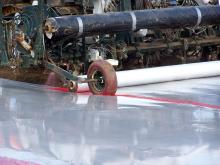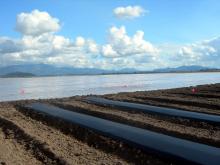Since 2009 there have been significant changes to fumigant product labels, which have resulted in changes to risk mitigation measures for the soil fumigants. These measures are for the soil fumigants chloropicrin, dazomet, metam sodium/potassium, and methyl bromide. All persons involved with soil fumigation (handlers, growers, and certified applicators) should be aware of these changes and consult labels prior to application. Safety measures for the soil fumigants implemented in 2012 include:
- Agricultural Worker Protection: Persons engaged in any of a number of activities that are part of the fumigation process are considered “handlers.” New restrictions address respiratory protection, tarp handling, and an entry-restricted period.
- Good Agricultural Practices: Many good agricultural practices are mandatory on the new labels to minimize inhalation and other risks from fumigant applications. Examples of good agricultural practices include proper soil preparation/tilling, ensuring optimal soil moisture and temperature, and appropriate use of sealing techniques.
- Application Method, Practice and Rate Restrictions: Certain fumigant application methods will be restricted. These include certain untarped applications for some fumigants. The label may also lower the maximum application rate.
- Restricted Use Pesticide Classification: All of the soil fumigants meet the criteria for restricted use.
- Site-Specific Fumigant Management Plans (Partial):
Fumigant users are required to prepare a written, site-specific fumigant management plan (FMP) before fumigations begin. Visit https://www.epa.gov/soil-fumigants/fumigant-management-plan-templates-phase-2-files-listed-chemical for FMP templates for each fumigant. - Buffer Zones: Fumigant users are required to establish a buffer zone around treated fields. Buffer zone distances are scenario-based using applicable site conditions, and will be provided in look-up tables on product labels. Credits will be given to encourage users to employ practices that reduce emissions (for example, use of high-barrier tarps) thereby reducing buffer distances. Some credits will also be available for site conditions that reduce emissions (e.g., high organic or clay content of soils).
- Posting Requirements: Buffer zones must be posted at usual points of entry and along likely routes of approach to the buffer unless a physical barrier prevents access to the buffer. The signs must include a “do not walk” symbol, fumigant product name, and contact information for the fumigator.
- Emergency Preparedness and Response Requirements: Site-specific measures in areas where bystanders may be close to fumigant buffer zones are required. Fumigators may choose either to monitor the buffer perimeter or to provide emergency response information directly to neighbors.
- If the fumigator chooses to monitor, the emergency response plan stated in the FMP must be implemented if the person monitoring experiences sensory irritation or if air concentrations reach action levels on labels. This monitoring must be done four times per day during the buffer zone period at times when the greatest potential exists for fumigants to move off-site.
- If the fumigator chooses instead to provide emergency response information directly to neighbors, the certified applicator supervising the fumigation, or someone under his/her direct supervision, must ensure that nearby residents and business owners/operators have been provided the response information at least one week prior to the fumigant application. The method for distributing information to neighbors must be described in the FMP.
- Compliance Assistance and Assurance Measures: In states that require notification of fumigant applications, fumigators must notify State and Tribal Lead Agencies for pesticide enforcement about applications they plan to conduct. This information will aid those states in planning compliance assistance and assurance activities.
For more information visit the following websites:
- EPA, About Pesticides—Soil Fumigant Phase 2 Labels Take Effect
https://archive.epa.gov/pesticides/news/web/html/phase2-soilfumig.html - EPA, Pesticides: Reregistration—Implementation of Risk Mitigation Measures for Soil Fumigant Pesticides
https://archive.epa.gov/pesticides/reregistration/web/html/index-290.html - ODA Pesticides
https://www.oregon.gov/oda/programs/Pesticides/Pages/AboutPesticides.aspx - Washington State Department of Agriculture, Pesticides & Fertilizers
https://agr.wa.gov/departments/pesticides-and-fertilizers/pesticides - State of Idaho Agriculture, Pesticides & Chemigation
https://agri.idaho.gov/main/56-2/chemigation/



